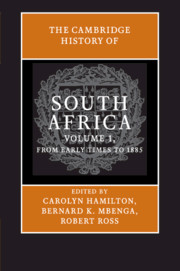Book contents
- Frontmatter
- 1 The Production of Preindustrial South African History
- 2 The Appearance of Food Production in Southern Africa 1,000 to 2,000 Years Ago
- 3 Farming Communities of the Second Millennium: Internal Frontiers, Identity, Continuity and Change
- 4 Khoesan and Immigrants: The Emergence of Colonial Society in the Cape, 1500–1800
- 5 Turbulent Times: Political Transformations in the North and East, 1760s–1830s
- 6 From Slave Economy to Settler Capitalism: The Cape Colony and Its Extensions, 1800–1854
- 7 From Colonial Hegemonies to Imperial Conquest, 1840–1880
- 8 Transformations in Consciousness
- Index
- References
5 - Turbulent Times: Political Transformations in the North and East, 1760s–1830s
Published online by Cambridge University Press: 28 September 2010
- Frontmatter
- 1 The Production of Preindustrial South African History
- 2 The Appearance of Food Production in Southern Africa 1,000 to 2,000 Years Ago
- 3 Farming Communities of the Second Millennium: Internal Frontiers, Identity, Continuity and Change
- 4 Khoesan and Immigrants: The Emergence of Colonial Society in the Cape, 1500–1800
- 5 Turbulent Times: Political Transformations in the North and East, 1760s–1830s
- 6 From Slave Economy to Settler Capitalism: The Cape Colony and Its Extensions, 1800–1854
- 7 From Colonial Hegemonies to Imperial Conquest, 1840–1880
- 8 Transformations in Consciousness
- Index
- References
Summary
“THE WARS OF SHAKA,” THE MFECANE, AND BEYOND
This chapter focuses on the nature and causes of the major political transformations that took place in the later eighteenth and early nineteenth centuries in the region bounded roughly by the Orange River, the Kalahari Desert, and the Indian Ocean. The notion that the years from the 1760s to the 1830s constitute a discrete period in this region’s history, a period defined by the working-out of an identifiable set of transformations, is of very recent origin. Before the 1970s, historians had long been treating the three decades after about 1810 as a period on its own, one defined primarily by the rise and supposedly explosive expansion of the Zulu kingdom under Shaka, the supposedly consequent destabilizing of much of the eastern half of Southern Africa, and the emergence of a number of new kingdoms in this area. With few exceptions, historians paid very little attention to the decades before 1810 except to describe briefly the emergence of Shaka’s supposed precursor, Dingiswayo of the abakwaMthethwa. In the 1970s and 1980s, as historians began to develop new approaches to the study of African pasts, and to tap more widely into the available source material on precolonial Southern Africa, they began to investigate the political and social history of specific African societies of the later eighteenth century in more detail and over a wider area. However, they still tended to see these years as forming a kind of preface to the Zulu expansion and the “wars of Shaka,” or mfecane, as they came to be called from the late 1960s onward.
Information
- Type
- Chapter
- Information
- The Cambridge History of South Africa , pp. 211 - 252Publisher: Cambridge University PressPrint publication year: 2009
References
Accessibility standard: Unknown
- 3
- Cited by
